Tulalip Tribes Annual Veterans Pow Wow, June 5-7
April 8, 2015 Tulalip See-Yaht-Sub
Augusta G. Lobehan
Augusta G. Lobehan of Auburn, Wash. went to be with our Lord on March 24, 2015.
Augusta was mostly known as “Gus” or “Scotty”. Gus was born to William Sam, Sr. and Carole Allen on August 16, 1960.
She was raised in her early years in Tulalip by her parents and also lived with Don “Penoke” and Barbara Hatch. As a teen she moved to Muckleshoot to live with Kenny and Charlotte Williams and her Mom and Step Pops Don Allen. September 26, 1994 she married Archie Lobehan. Ever since they were inseparable. He has the same compassion as his wife, taking care of others. Both natural caretakers.
Services will be visiting at Weeks Funeral home in Buckley Friday March 27, 2015 from 1-3 p.m. Candlelight service at Muckleshoot Pentecostal Church at 7 p.m. Funeral service at Tulalip Gym on Saturday March 28, 2015 at 10 a.m. Burial following at Mission Beach Cemetery. Service directed by Weeks’ Funeral Home. Please sign the online guest book at weeksfuneralhomes.com
One-on-One with basketball stand-out Adiya Jones

photo courtesy Adiya Jones.
By Micheal Rios, Tulalip News
On Wednesday, April 1, 2015 the Associated Press announced their All-State basketball teams for boys and girls high school players, as voted on by sports writers and editors from around the state. La Conner High School junior and Tulalip tribal member, Adiya Jones, was named to the First Team for all Class 2B girls’ high school players in the state.
Prior to this past year Adiya was the face of the Heritage High School girls’ basketball team. She was part of a successful season in her freshman year, followed by being the focal point of the team’s offense in her sophomore year as she led the team in scoring and rebounding. It was expected she would again be the team’s star player in her junior season, but in a twist she opted to transfer out of Heritage and play at La Conner High School. Adiya and her mother, Charlotte Jones, relocated to the small town of La Conner in order for her to attend the local high school.
Over the next several months Adiya would become part of a new community and lead a new group of teammates on the basketball court. In fact, Adiya excelled at La Conner, both on and off the court, resulting in her being named co-MVP of the Northwest 2B Basketball League and leading her team to a 3rd place finish in the 2B State Tournament. Adiya sat down for an interview with the See-Yaht-Sub to tell her story to her tribal membership.
When did you first start playing basketball?
“I honestly didn’t like basketball when I was younger. I was a long-time cheerleader and loved to dance. Then before 7th grade I hit a growth spurt and being taller now I decided to try out for the basketball team. It didn’t work out. I was cut from the team, but decided at that moment I was going to come back and try out again next year. I worked out that summer and trained with Tori Torrolova, the Tulalip Boys and Girls Club athletic director. She really worked with me on improving my game and teaching me the fundamentals.”
So you’ve only been playing organized basketball for a little over four years then?
“Yeah, looking back I’m still surprised that I’ve accomplished what I have, being that I haven’t played basketball nearly as long as other girls I know. It came to me naturally after working out with Tori and getting help from my coaches along the way.”
Why did you transfer out of Heritage H.S. and why did you choose La Conner H.S. to transfer to?
“I’ve always wanted to go to a much better school academically. I miss Heritage, but I feel like moving up here was huge for me because I have many more opportunities available to me now. Originally, before making the decision, I met with [La Conner basketball coach] Coach Novak to talk about how I’d fit in and what our goals would be. After meeting with him I knew La Conner is where I wanted to go.”
Was it difficult adjusting to a more traditional curriculum?
“The quality of education is a big difference maker. The curriculum at La Conner is completely different. At first it was really hard to adjust. The first week I didn’t think I was going to make it. There’s homework every night. Here, they are prepping us for college. It’s a really good school. I’ve learned so much during this school year. I’m really happy I made the change because I’m learning every day.”
At La Conner you mentioned they have curriculum that really challenges you and helps you to succeed. How so?
“They have TAs and parents that come in to help students get homework done or particularly tough assignments. For me, at one point I had a tutor come in and help me for like four weeks with homework and writing papers. When I first came to La Conner I didn’t even know how to type up a full paper and edit because we didn’t do that at Heritage. At La Conner they have people who are there to help you and to support you to make sure you are understanding and able to do the work. The first week I felt like this wouldn’t be the place for me because I wasn’t used to this kind of environment and the curriculum was completely different. I kind of felt dumb at first, but after a few weeks I become more comfortable because I was getting the help that I needed. The faculty and tutors helped me to adjust. They wanted me to succeed and that made all the difference.”
Do you feel you’re getting better prepared for college life?
“Yeah, because they really hold you accountable for your homework and deadlines for assignments. They want you to succeed and recognize when you need one-on-one attention to understand the curriculum.”

photo courtesy Adiya Jones.
How does the style of play differ from what you were used to at Heritage?
“There’s a big difference. Coach Novak is really about structure and bases our game off of defense and set plays. The first week all we did was conditioning, other than that, the rest of our practices were focusing on our sets. At Heritage it was basically a few plays and half the time we didn’t run them. It was a huge change because back at Heritage it was mainly like, ‘get the ball to Adiya.’ Most of the plays were based off me, whereas here at La Conner it feels really good to have support and not be relied on to carry the offense all the time.”
How is the competition different playing in a larger league?
“Our league isn’t the best, but it’s an improvement competition-wise. We get more good competitive games, and for me I get to match up with girls who are my size or bigger with skill. At Heritage, district 1B, there weren’t that many girls bigger than me or taller than me so I wasn’t challenged in the ways that I am playing for La Conner. Being challenged makes me play better and improve my game.”
What was the adjustment period like playing with a brand new team?
“It helped a lot that Coach Novak had us all play fall league together before our high school regular season started. At first it was kind of hard to adjust, but we learned each other’s games pretty quick. Our point guard, Kamea Pino, was also a transfer student and new to the school like me. It helped me and her bond, both being the new players on the team. It really showed how we came together in a short amount of time by starting the season like we did.”
Before your first basketball game for La Conner, did you have any doubts about your skills in a different league?
“Yeah, I had doubts. I didn’t even know if I was going to be a starter. Coach Novak was really good about working with me to calm my nerves in the very beginning. “
But then you went on to be a starter and had a great season. You even averaged 16.3 points per game. Did that validate your skills as a basketball player?
“Oh yeah, fitting in as quickly as I did and taking on a good portion of our offensive sets really let me know that I could find a way to play in any league. Being able to score on better competition and then winning the Skagit Valley Herald Girls’ basketball player of the year was one of the best feelings.”
You guys got off to a really good start and in fact went undefeated during the regular season. At what point did you realize you had a real shot at winning the state title?
“I think it was towards the end of the regular season when we knew we’d be league champs. There was a week where we won our league and then came together, as a team to overcome some challenges at the district tournament. Really coming down to it, it was at that time that as a team we recognized we could win state.”
Going into the semi-finals at State your team was 24-0 and had a 10 point lead in the 4th quarter, but ending up losing the game. What happened?
“The easy answer is I fouled out with a few minutes to go. If I don’t foul out then I 100% believe we would have won that game. It was late in the game and I was exhausted from all the ball we’d been playing and I picked up some errant fouls that ended up being the difference. It was a really tough loss.”
But then your team bounced back in the 3rd place game, right? That’s still a nice accomplishment in your first year with La Conner to go 25-1 and place 3rd in the state tournament.
“Yeah, we were shocked after losing our first game of the season, but we came together and wanted to still finish the season strong. I was so mad at myself for fouling out in the semi-finals and was determined to end the season with a good game. In the end, whether we took 3rd place or not we were all happy as a team to be one of the top teams in the entire state.”
Now you have that extra motivation to come back even better next season and to hopefully win it all at state.
“Definitely. We have three returning starters and will be even hungrier to win the state championship. For me, it was my first experience playing on that level and now I know what it takes to take that next step. I’m all about basketball right now and focused to win a state championship. I’m not even playing a spring sport right now so that I can play spring league basketball. Plus, it’ll be my senior year, my last season of high school ball, so that’s even more added motivation for me to get better for myself and my teammates.”
Outside of school and basketball, how are you liking living in La Conner?
“It’s a very uplifting atmosphere and easy to get adjusted to. Over here there is definitely less drugs, so it’s good to be away from that type of environment. It’s so friendly here, like everyone is friendly and it’s very peaceful. I could walk to the store and people who I don’t even know recognize me as a basketball player and say ‘Congrats’ or ‘good job!’ and it feels really good to have people I don’t know acknowledge me like that.”
Who are your favorite basketball players to watch?
“On the professional level I don’t really watch WNBA, but in the NBA my favorite player is Kevin Durant. On the collegiate level my favorite player is Breanna Stewart at the University of Connecticut. I’ve been watching her the last couple years and try to copy some of her moves.”
I hear you plan on playing some ball in Europe during the summer. What’s that about?
“It’s such an exciting opportunity. I’ve been invited by the ACIS program to play basketball in Italy from July 15-21. I’ll be able to learn about the game on a whole new level and learn about that culture. I’m kind of scared to be in a new country, but I’m more excited for the opportunity to showcase my skills. It’s going to be a lot of fun.”
What areas of your game are you going to focus on improving before the start of your senior season?
“Really working on better post moves is my main goal. I’ll be working on my conditioning too so that I’ll be in the best shape possible to be quicker on the court. Now, I know what it takes to the next level, to the championship game and I want to become a great player so that I’m prepared to take that next step.”
You averaged 16.3 points per game this past season as a junior. What is your goal to average in your senior season?
“My goal is to average at least 20 points per game. I think I can do it and being my senior year that would be a good goal to accomplish, along with winning a state title.”
Fawn Sharp Discusses Steps to Stemming the Tide of Climate Change
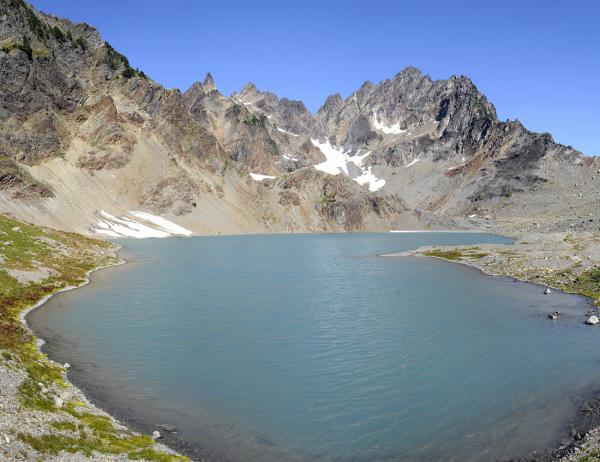
“Our Mount Anderson glacier is gone. It was there for thousands of years and over the past few years it simply melted. That is warming the water and making salmon restoration more challenging.”
Quinault Nation President Fawn Sharp appeared before the House Interior Appropriations Subcommittee in Washington, D.C. on March 24 to request federal funding to support the relocation of homes, public buildings and schools out of a tsunami zone in the coastal village of Taholah.
Sharp’s testimony came a week after the Affiliated Tribes of Northwest Indians, of which she is president, hosted a summit, “Asserting Native Resilience – Protecting and Enhancing Tribal Resources and Sovereignty in the face of Climate Change.”
After her House subcommittee testimony, Sharp – a University of Washington-educated lawyer and former state administrative law judge – talked with ICTMN about the summit and what she believes the next steps must be to stem the tide of climate change and the devastation that would follow.
RELATED: Climate Change: Mankind Must Stop Destroying ‘Our Own Mystical Place’

What are some of the extreme examples of climate change that were presented at the meeting?
As we have known for some time, our ocean waters are acidifying due to increased pH levels caused by carbonic acids that result from the release of carbon dioxide into the atmosphere. It’s estimated that up to 40 percent of the carbon released by humans enter the ocean, as well as rivers and lakes.
Generally speaking, there is nothing new about this. But the increased levels of carbon released by humans since the industrial age has had major impacts and, as population has expanded in the U.S. and elsewhere, the increased amount of automobile emissions as well as other fossil fuel emissions have led to ever-increasing change in the form of water temperature increases and acidification.
So should this concern us? It absolutely should, because it is impacting the ecosystem. People should never think they live in some form of protected bubble, or that they can ignore the environment and get along just fine.
People are just as dependent on a healthy ecosystem as every other living creature on Earth, and anytime any specie is in danger, we are affected. But, whether due to fear of losing their job or a feeling of helplessness or some inaccurate information they might have heard somewhere, far too many people do nothing about it. They ignore it or even deny it. That’s just not good enough.
Everyone who lives on our Mother Earth has a responsibility to protect her. Everyone who drinks water in one form or another has a duty to assure it is pure. And every person who breathes God’s air is responsible for its quality.
The ocean is warming. It has become acidified. The sea level is increasing, increasing the intensity of storm surges, as well as flooding, erosion, forest fires and habitat loss. Glaciers have melted or are melting, causing rivers and lakes to warm and making them uninhabitable for fish. We feel all of these impacts at Quinault Nation. Our Mount Anderson glacier is gone. It was there for thousands of years and over the past few years it simply melted. That is warming the water and making salmon restoration more challenging.
What are some innovative ways tribal nations are responding to the challenges presented by climate change?
There are innovative approaches being used or planned by some tribal nations but the bottom line is that Mother Nature’s ways are best. Fish and wildlife need a healthy environment, just as people do. Securing those resources and protecting them for future generations requires respect for the environment. It’s an old tribal value to take only what you need from Nature to survive, and use all that you take. It’s also an old value to base the decisions one makes today on the impacts they will have seven generations from now.
As my very good friend Billy Frank Jr. used to say, “You have got to see the big picture.” Those who rush to drill every drop of oil they can now so they can get as rich as they can, regardless of the impact on the environment, do not see the big picture. Those who neglect the environment when they use pesticides or buy high gas-consumption cars don’t see the big picture. Those who neglect instream flows in their quest for irrigation water or build dams on rivers simply do not see the big picture.
But to answer your question, there are many ways that tribes are being innovative in responding to the climate change problem. This is probably the biggest environmental problem that exists in the world today. So tribes have been gathering, as nations, on a national and international scale to share ideas, consolidate plans and garner strength in their efforts to have a strong voice in their call for the countries of the world to change their ways. We want them to stop poisoning the planet, stop killing all the animals and plants and stop destroying all the habitat. We have been working with the United Nations and other international organizations to achieve the level of recognition the Indigenous Peoples of the world deserve.
We have reached out and been a part of many efforts designed to see solutions to climate change. I served on the Governor’s Carbon Emissions Task Force all summer long as we developed a gas tax plan for the state, which is now being considered in the legislature.
Virtually every tribe in the state is involved at some level in protecting, enhancing or restoring habitat. Quinault has been for many years. Those efforts are constantly innovative in their approach – whether our scientists are developing new ways to place trees in the river to regain natural hydraulics in the system or devising new ways to place gravel for spawning habitat. We invest in our science and in our river, lake and marine restoration and protection programs because it supports our future, it is true to our heritage and because it’s the right thing to do.
(Sharp then shared information about the Swinomish Tribe’s Climate Change Initiative, which can be viewed at here.)
What will ATNI do with the information that was presented at the climate change summit?
ATNI will work with a group of tribal representatives from Pacific Northwest Tribes and Inter-Tribal organizations, in collaboration with federal, state and local governments, to prepare summary recommendations on the following by the next ATNI convention in Warm Springs, Oregon on May 18-21:
One, begin to identify Pacific Northwest Tribal needs for climate change and organize tribes regionally to support increased funding, technical support, and capacity to address those needs.
Two, identify strategies to promote and protect tribal sovereignty and tribal resources.
Three, prepare a strategy to engage Pacific Northwest Tribes on developing a policy framework for a “Pacific Northwest Tribal Action Plan on Climate Change, Energy, and Greenhouse Gas Emissions,” similar to California, Oregon, Washington and British Columbia’s “Pacific Coast Action Plan on Climate Change, Energy, and Greenhouse Gas Emissions.”
Four, coordinate Pacific Northwest Tribes’ actions on climate change into a cohesive and effective strategy in order to inform regional, national, and international policy.
Five, adopt a resolution at ATNI’s May 2015 convention to bring climate change issues, policies, and strategies to the National Congress of American Indians national convention.
In addition to the outcomes of this summit, the Affiliated Tribes of Northwest Indians support the findings of the State, Local, and Tribal Leaders Task Force on Climate Preparedness and Resilience established by Executive Order 136531.
(Sharp then reviewed those recommendations, which can be read at here.)
How are tribal nations seeing the effects of climate change, perhaps in ways that people outside of Indian country are not seeing them?
Climate change is expected to significantly alter the ecology and economy of the Pacific Northwest, and tribes and Native communities are among the most climate-sensitive groups within this geographic area.
Models predict warmer temperatures, more precipitation as rainfall, and decreased snowfall over the next 50 years which will directly affect the abundance of culturally significant foods, such as salmon, deer, root plants, and berries. These foods are important for ceremonies and subsistence, and access to traditional hunting, fishing, and gathering sites is guaranteed by treaty, constitution, or other agreements with the federal government. Increasing the climate resilience of tribal governments and Native communities is critical to ensuring access to resources protected by right and vitally important to the cultural existence and economic vitality of these communities.
Tribes must proactively begin to address these impacts, assess their vulnerability, and develop adaptation strategies. A few Northwest tribes are developing their internal technical, legal, and policy capacity to comprehensively address climate change impacts – however, much more work is needed. Although many tribes have been involved [in] habitat and climate change-related efforts, less than 5 percent of tribal governments – 25 [federally recognized] tribes out of 566 – nationwide have developed climate change vulnerability assessments or adaptation plans.
What action does ATNI want to see taken in order to see some positive impacts immediately?
Funding of Northwest tribes is critical. The principal funding source for Tribal Climate Change is the Bureau of Indian Affairs. In fiscal year 2013, the BIA had only copy million allocated to tribal governments nationwide. In fiscal year 2014, there was to be copy0 million appropriated for Tribal Climate Change programs, however those funds have either been re-appropriated within the Department of the Interior or have not yet reached tribal governments. The ATNI-member tribes are seeking an increase of $50 million for the BIA Climate Change Program for fiscal year 2016 and beyond.
Support is needed for tribes to prepare for the unique impacts they face as a result of climate change. The federal government must fully incorporate its government-to-government relationship with tribes and Alaska Native communities into existing programs and activities that relate to climate change by enhancing self-governance capacity, promoting engagement of state and local governments with tribal communities, and recognizing the role of traditional ecological knowledge in understanding the changing climate.
Read more at http://indiancountrytodaymedianetwork.com/2015/04/01/fawn-sharp-discusses-steps-stemming-tide-climate-change-159826
Father of Marysville-Pilchuck shooter arrested on gun charge
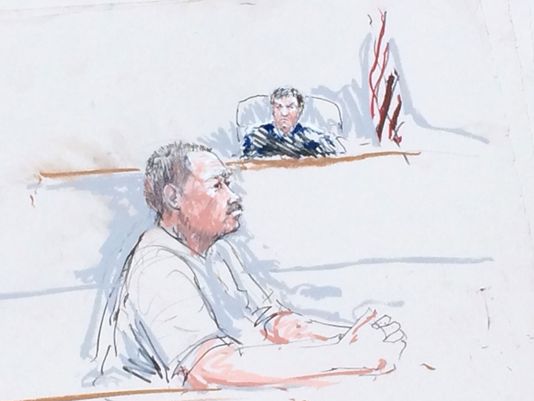
Travis Pittman, KING 5 News
SEATTLE – The gun used by Marsyville-Pilchuck High School shooter Jaylen Fryberg to kill four classmates and himself last year was illegally purchased by his father, according to federal court documents.
Raymond Lee Fryberg, 42, appeared in federal court Tuesday afternoon on unlawful possession of firearms.
Raymond Fryberg was under a permanent protection order from Tulalip Tribal Court after Raymond’s then-girlfriend claimed in 2002 that he had threatened and assaulted her.
In 2012, Raymond pleaded no contest after being charged with violating the order and was sentenced to a year of probation.
As part of the protection order, Raymond was not allowed to purchase firearms. But the court documents reveal that he purchased five firearms from a Cabela’s store in Tulalip, Wash., between January 2013 and July 2014. When he purchased the guns, he falsely indicated on the purchasing agreement that he was not under a protection order.
Investigators at the Marysville-Pilchuck shooting on October 24, 2014, later identified the gun that Jaylen Fryberg used – a Baretta PX4 Storm – as the one of the guns Raymond Fryberg purchased.
Jaylen Fryberg, 15, shot and killed his cousin Andrew Fryberg, 15; Gia Soriano, 14; Shaylee Chuckulnaskit, 14; and Zoe Galasso, 14 inside the school cafeteria. Jaylen also wounded 14-year-old Nate Hatch before turning the gun on himself.
Statement from Marysville superintendent Dr. Becky Berg:
“We are saddened by this morning’s news. Our hearts go out to the victims’ families, our students, staff and community as we continue through the long process of recovery. This is part of an ongoing investigation and all questions related to this matter should be deferred to the FBI.”
Statement from Cabela’s:
“Cabela’s strictly complies with federal, state and local laws regulating the sale of firearms. Cabela’s records indicate the transaction was processed in compliance with applicable regulations, including background checks.”
Statement from Tulalip Tribes Chairman Herman Williams
“The Tulalip Police Department continues to coordinate with federal authorities. It is not our policy to comment on an active investigation and at this time we have no further information to share. Our thoughts and prayers continue to be focused on the victims, their families, and the healing of our communities impacted by the Marysville Pilchuck High School shooting.”
Father of Washington School Shooter Arrested on Gun Charge
By Gene Johnson, The Associated Press
The father of a Washington state high school student who killed four classmates and himself last fall was arrested Tuesday on a federal charge that he was barred from possessing the gun his son used in the shooting.
Raymond Lee Fryberg Jr., 42, faces one count of unlawful possession of a firearm by a prohibited person. An FBI agent alleged in a criminal complaint that even though Fryberg was subject to a domestic violence protection order, he purchased five guns from a Cabela’s outdoor recreation store, including the Beretta pistol his son used in the shooting, by lying on a federal form.
Jaylen Fryberg, 15, a well-liked freshman who had recently been a Homecoming prince, inexplicably shot and killed four friends and wounded another last October after inviting them to lunch in the cafeteria at Marysville-Pilchuck High School north of Seattle.
“Our office has a long history of working with our federal, state, local and tribal law enforcement partners across Western Washington to prosecute those who illegally possess firearms,” Annette Hayes, the acting U.S. attorney in Seattle, said in a news release. “This case is part of that effort and a reminder that we are united in our commitment to get firearms out of the hands of those who pose the greatest risk to our communities.”
Fryberg was due to appear in U.S. District Court on Tuesday afternoon. Federal court records did not indicate whether he had a lawyer.
According to the complaint, Fryberg’s then-girlfriend, the mother of one of his children, obtained a protection order against him in Tulalip Tribal Court in 2002, alleging that he had threatened her, slapped her and pulled her hair.
The order became permanent, and in September 2012, Fryberg entered a no-contest plea to a charge that he violated it. He was given a suspended sentence of six months and ordered again to comply with the terms of the order.
Just four months later, Fryberg went to a Cabela’s store on the Tulalip reservation and purchased the Beretta, the complaint said. He answered “no” on a federal form asking if he was subject to a court order restraining him from harassing, stalking or threatening a child or intimate partner, and he answered the same when he filled out forms for the purchase of four other weapons at the store between January 2013 and July 2014, the complaint said.
State Sen. John McCoy, a member of the Tulalip Tribe, said he didn’t know Fryberg had been subject to a restraining order.
“That’s exceptionally troublesome to me,” McCoy said. “It points me to the issue we’ve been arguing about in the state, that people are not going to tell the truth when they fill out the forms to buy a gun, so maybe we should have a registry of people who are subject to these orders. That’ll be more fodder for discussion.”
Pollution partially closes nearly 500 acres of Portage Bay shellfish beds
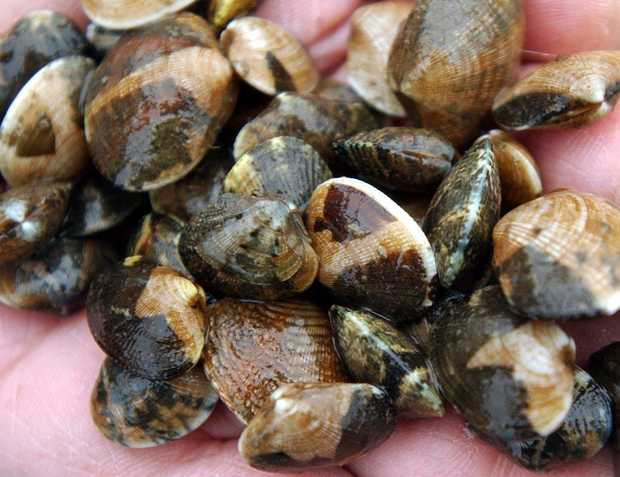
Ralph Solomon holds clams at the sea sea pond on the Lummi Reservation in this 2003 photo, shortly before the tribe reopened shellfish beds that were closed in 1996 due to poor water quality.
THE BELLINGHAM HERALD
By Kie Relyea, Bellingham Herald
LUMMI RESERVATION — Commercial shellfish harvesting is being banned on nearly 500 acres of Portage Bay for about half the year because of worsening water quality caused by fecal coliform bacteria, the Washington state Department of Health announced Tuesday, March 24.
Portage Bay is home to Lummi Nation’s ceremonial, subsistence and commercial shellfish beds.
State health officials last week changed the classification of nearly 500 of the 1,300 commercial shellfish harvesting acres in the bay from “approved” to “conditionally approved” because of water quality. That means harvesting in the conditionally approved area will be closed each year April through June and again October through December.
Those are the months when tests show the bay is affected by polluted runoff from the Nooksack River carrying higher levels of bacteria into the shellfish harvesting area, the state said.
The partial closure will remain until water quality improves, said Scott Berbells, manager of the growing area section for the department’s Office of Environmental Health and Safety.
The state’s action follows one taken by Lummi Nation in September, when the tribe closed 335 acres in Portage Bay to shellfish harvesting.
The tribe consulted with the state Department of Health and volunteered to do so Sept. 3 after levels exceeded federal standards for commercial shellfish harvest.
Those 335 acres are within the 500 acres downgraded by the state.
“This closure is devastating for the approximately 200 families on the Lummi Reservation who make their living harvesting shellfish,” Lummi Nation Chairman Timothy Ballew II said in a news release.
Fecal coliform bacteria come from human and animal feces. The bacteria enter Whatcom County’s waterways in several ways — horse and cow manure, pet and wildlife waste, and failing septic systems — and indicate there could be pathogens absorbed by the shellfish that may sicken people who eat them.
This isn’t the first time the tribe has closed its shellfish beds in Portage Bay because of fecal coliform pollution. It did so in 1996 because of high levels of fecal coliform in the Nooksack River and streams that empty into Portage Bay.
At that time, the state Department of Ecology and the Environmental Protection Agency led a cleanup plan using state legislation approved in 1998 that required dairy farms to undergo routine inspections and create written plans for how they would contain manure and prevent it from washing into public waterways. Before 1998, dairy farms were inspected only if a complaint was made about a farmer.
Failing septic systems and municipal sewage systems also were addressed.
The effort cleaned up the Nooksack River and its tributaries and allowed 625 acres of tribal shellfish beds to reopen in 2003, and the last 115 acres to reopen three years later.
“During the last 10-year closure, the tribal community lost jobs and millions in revenue. Ultimately, the closure affects all Lummi people because this shellfish area is sacred to our people and critical to our way of life,” Ballew said.
In recent years, the Lummis have expressed concern about water quality once again degrading because cuts to budgets and enforcement created regulatory gaps.
State officials also have been warning about worsening water quality.
“We’ve seen declining water quality in Portage Bay since about 2008. A number of stations have been steadily getting worse,” Barbells said.
Cleanup efforts are once again underway in the watershed.
In 2014, Whatcom County received funding from the EPA to strengthen a locally led effort to identify and clean up pollution sources.
Lummi Natural Resources, Whatcom Conservation District, and the state departments of Health, Agriculture and Ecology are working with Whatcom County and the Portage Bay Shellfish Protection District on the Portage Bay cleanup.
Peaceful place helps keep MP shooting victim’s memory alive
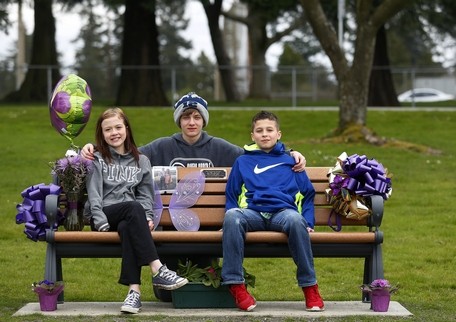
Gia Soriano’s cousins, 11-year-old Gabby (left) and 14-year-old Titan (middle), with Gia’s brother, 11-year-old Anthony Soriano, on a memorial bench Gia’s grandmother, Elaine, had installed in Legion Park in Everett. Gia Soriano was killed in the shooting at Marysville Pilchuck High School last year. The family will celebrate Gia’s birthday at the park on March 31.
By Andrea Brown, The Herald
EVERETT — This Tuesday would have been Gia Soriano’s 15th birthday.
Her name should be on a learner’s permit. Instead, it’s on a memorial park bench.
Gia Christine Soriano was among the four students fatally shot by a classmate in the Marysville Pilchuck High School cafeteria on Oct. 24. She died two days later.
A bench was recently installed in her honor in Everett’s Legion Memorial Park, overlooking Port Gardner Bay.
It’s a place where her family, her friends and the community can come to remember the sweet girl with the radiant smile.
An intimate birthday gathering is planned March 31 at the bench, which sits about 100 feet from Gia’s paternal grandparents’ home bordering the park.
“When Gia died, I thought right away we are going to get a bench,” said grandmother Elaine Soriano, who led the project. “I know how much people enjoy coming for the view. I wanted it to be close to my house, so when I get old I can still get to the bench.”
She ordered the bench from Everett Parks and Recreation Department and paid the $3,500 herself. Donations reimbursed her the cost.
Many of Gia’s close relatives live in Everett, where the family has strong ties.
“I drive by here all the time on my way to work,” said Gia’s father, Bryan Soriano, a longshoreman like his father. “At first it was hard that it was here. You show up and it’s real. It just reminds you. Just like going to the cemetery is hard, too. It’s still fresh.”
Embedded in the concrete base of the bench is a tiny silver angel. A plaque has an inscription with Gia’s initials framing the sentence: “God’s Incredible Angel.”
The bench is a bittersweet monument.
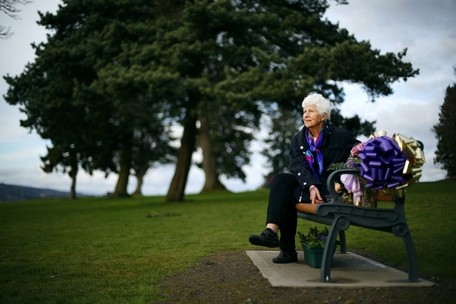
Elaine Soriano worked with Everett Parks & Recreation to install a memorial bench for her granddaughter Gia Soriano at Legion Memorial Park in Everett.
“It gives some solid ground to how we’re feeling,” said Gia’s mother, Susan Soriano. “It’s a statement and it’s here for life, where she isn’t.”
The park is a calm spot with a backdrop of sparkling waves and multicolored skies.
“A soft-spoken place for a soft-spoken girl,” her mom said. “Because that’s what she was, so I think it’s perfect.”
The bench looks festive, with big shiny bows and colorful flowers.
It contrasts with the aching void that family members face trying to cope with the loss of Gia and the violent way her life was taken from them.
“Everything is different now,” said Gia’s mom.
“Everything is hard,” said Gia’s aunt, Gay Soriano. “I was registering my son Titan for high school the other day and I just started bawling in a room full of people. You can’t get it out of your head. It’s turned everything and everybody upside down.”
“It ruined our family,” said Gay’s daughter, 11-year-old Gabby, who idolized Gia. “It made a gap and it did that to the other families, too. It makes me really angry and mad and sad.”
Gabby sees a grief counselor and speaks openly about her anguish and anger.
“The boys, on the other hand, I worry about,” Gay Soriano said. “Boys don’t say much. They’re thinking about it. They just don’t verbalize it like Gabby.”
After the photo session on the bench, Titan and Gia’s brother, Anthony, 11, raced around the park and climbed a tree.
Gabby soon joined them, wearing Gia’s gray “PINK” sweatshirt.
Gia’s gravesite is in Evergreen Cemetery.
“My daughter and I go to the cemetery a lot,” Gay Soriano said. “This is a better place for people in the community and her friends from school to gather and remember her. It’s more of a grounding place. Where it’s located and how the sun sets on it every day is kind of a special thing.”
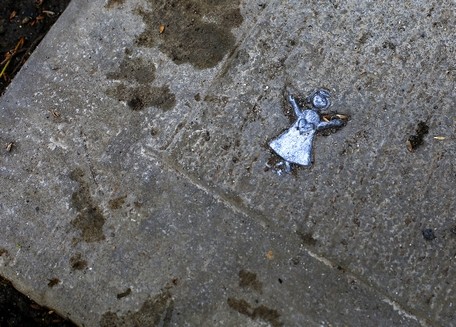
Embedded in the concrete base of the bench is a tiny silver angel. A plaque has an inscription with Gia’s initials framing the sentence: “God’s Incredible Angel.”
Elaine Soriano and her husband, John, a retired longshoreman, moved to the house adjacent to the park 25 years ago. They wanted a place for the generations to gather. It didn’t get better than having a park right outside the door to play and picnic.
Gia’s dad, Bryan, is the youngest of the couple’s six children. All graduated from Everett High School, as did Elaine and John.
“Giovanni” is John’s birth name, but he got it legally changed when he was 12 for something less Italian and more mainstream.
“All the kids think Giovanni was a neat great name,” Elaine Soriano said. “So Gia was going to be Giovanni if she was a boy.”
There are other memorial benches in the park, but Gia’s is closest to their home.
The grandmother picked the spot. “We’d have leaf fights and walk through the puddles over there, and just run around,” she said. “We had so much fun.”
Elaine Soriano laments it was supposed to be her name on the bench, not her granddaughter’s. “I always told my children I would like a bench in the park,” she said.
The park bench helps her carry on. “Gia would say, ‘Ohhh, this is neat.’”
It’s in plain view from her living room. She keeps tabs on who’s visiting the bench and freshens the flowers. When she’s not home, an angel statue faces out the window to keep watch.
“I’m going to get a little cute mailbox and let people leave a note for Anthony. Or Grandma Elaine,” she said. “A metal mailbox to hang on the side of the bench. I guess I have to ask the parks department first. I’ll tell them I’ll just tie it on with ribbon.”
The house is a shrine to Gia, with pillows and ribbons in purple, the teen’s favorite color, and numerous photos of her stages of life. A favorite is of Gia in her dress at the homecoming dance days before the shooting.
“We have 15 grandchildren,” Elaine Soriano said.
She includes Gia in the count.
Gia’s childhood drawings and Baptismal dress hang along the hallway. She is ever-present.
The park bench on Alverson Boulevard is about a mile from Providence Regional Medical Center Everett where Gia was rushed after the shooting that ended hers and the other young lives at the lunch table that day. Zoe Galasso, 14, Andrew Fryberg, 15, and Shaylee Chuckulnaskit, 14, also died, as did the shooter, 15-year-old Jaylen Fryberg, who killed himself. Nate Hatch, 15, is the only survivor. All the victims were shot in the head.
“There was nothing they could do. We knew that from day one. They gave it to us straight up,” Gia’s father said.
During their bedside vigil at Providence, her mother showed Everett neurosurgeon Dr. Sanford Wright Gia’s school homecoming photo.
“I wanted him to see what she looked like,” she said, “because she looked so different in the hospital.”
The parents praise the medical team.
“We couldn’t have been in a better place. I’m glad we didn’t end up down in Seattle,” Bryan Soriano said.
“The reason we kept her alive for a few more days was for her organs. We’re glad we donated the organs because we got a letter that was just beautiful. It told us where all her organs went. It didn’t say who, their names, it just said their gender and age and what they received. Her liver. Her kidney. Her lungs. A 10-year-old got her corneas, so he can see now.
“They couldn’t use her heart. That would have been the best thing to give somebody, was her heart.”
Andrea Brown: 425-339-3443; abrown@heraldnet.com. Twitter: @reporterbrown.
Friends of Peace Scholarship
A scholarship at Everett High School has been established in memory of Gia Soriano and Zoe Galasso, two students killed Oct. 24 in the Marysville Pilchuck High School shootings.
The Friends of Peace Scholarship was created by friends and former teachers in honor of the students’ parents, Bryan and Susan Soriano and Michael and Michelle Galasso. The Sorianos and Michelle Galasso are alumni of Everett High.
The scholarship will be granted to an Everett High graduating senior who has overcome a traumatic life experience and who is interested in pursuing more education after high school.
The scholarship will be managed by the Everett Public Schools Foundations. Donations may be sent to Everett Public Schools Foundation, P.O. Box 3112, Everett, WA 98213 or online at epsfoundation.org, referencing the Friends of Peace Scholarship.
For more information, send email to jlevin@everettsd.org or call 425-385-4693.











